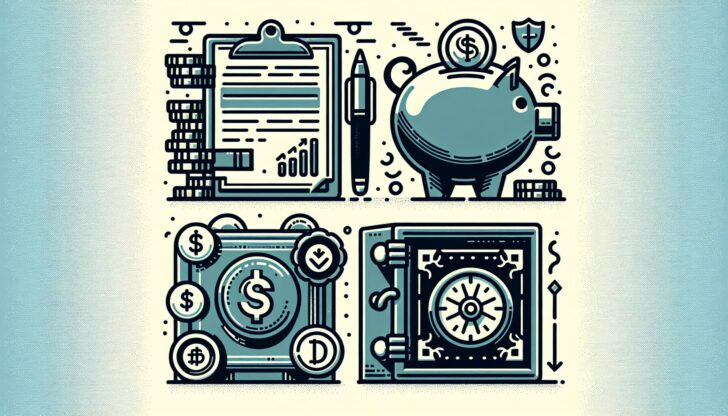Deciding on the type of account in bank to open can directly impact your financial management and growth. From everyday spending to long-term savings, different accounts serve distinct purposes: checking accounts for daily use, savings accounts for earning interest, Certificates of Deposit for time-bound investments, and money market accounts for a balance of accessibility and growth. This guide provides a clear overview of each account type to help you choose the right fit for your financial journey.
Table of Contents
Key Takeaways
Bank accounts, such as checking accounts, savings accounts, CDs, and money market accounts, cater to various financial goals like daily spending, growth, investment, and a mix of accessibility with earnings.
Specialized bank accounts, including high-yield savings and business banking solutions, offer tailored benefits for maximizing interest, dealing with international transactions, or managing business finances.
Understanding and navigating bank account features and fees is essential to optimize your financial strategy, and leveraging online banking can enhance convenience, security, and customer satisfaction.
Exploring the Main Types of Bank Accounts

In the realm of personal finance, various types of bank accounts exist within financial institutions, each tailored to different aspects of your economic life. At their core, bank accounts provide a secure and convenient place to deposit funds, withdraw money, and conduct transactions with ease. Whether you’re looking to manage everyday expenses or grow your savings, a financial institution offers a range of deposit accounts that can be matched to your financial objectives. We will demystify the primary deposit account types – checking accounts, savings accounts, and Certificates of Deposit (CDs) – to understand how each can fuel your financial aspirations.
While these accounts share the common purpose of safeguarding your money, they differ in their functionality and benefits. From the flexibility of checking accounts facilitating your spending and bill payments to the growth-oriented nature of savings and investment accounts, understanding these differences is pivotal. While exploring the significant aspects of banking, it’s vital to consider both the process and the financial goal it helps achieve.
Everyday Transaction Accounts: Checking Accounts
For those who revel in the art of daily money management, checking accounts are the linchpins that hold the financial gears in motion. They are the quintessential elements for depositing income, managing expenditures, and keeping the cash flowing for everyday needs. The introduction of debit cards places the power to make purchases, pay bills online, and transfer funds seamlessly at your fingertips. However, among these conveniences, one must stay aware of potential drawbacks such as fees, minimum balance requirements, and accessibility.
Checking accounts are not designed as tools for earnings; their essence lies in fluidity and accessibility, not in growth. They are the workhorses of personal finance, equipped with modern conveniences like contactless payments and round-the-clock mobile banking. When considering the features of a checking account, think about how it integrates into your daily financial routine.
Growth-Focused: Savings Accounts
Savings accounts are the vessels for your aspirations, be it an emergency fund bracing for unforeseen storms or a vacation fund for sunnier days ahead. These deposit accounts, including a savings account, are sanctuaries for the money that you earmark for future use, earning interest over time and often accompanied by minimum balance requirements and fees that prompt you to save rather than spend. With each contribution, you’re building a foundation for financial security, a cushion for emergencies, or a stepping stone towards a specific financial goal.
While the liquidity of savings accounts is more restrained to foster saving habits, the interest rates offered can turn these accounts into sources of passive income. Traditional to high-yield, these variations of savings accounts are tailored to your saving style and objectives, from short-term goals to long-term ambitions. While growing your savings, pay close attention to the interest rates and fees to make sure your savings increase as planned.
Investment-Driven: Certificates of Deposit (CDs)
Certificates of Deposit (CDs) are the financial embodiment of patience, offering a sanctuary for your funds to flourish untouched, while you earn interest at a fixed interest rate over a predetermined term. CDs are the epitome of predictability in an unpredictable market, securing a stable return on investment and shielding you from the whims of fluctuating interest rates. The rigidity of the term length and the associated early withdrawal penalties are the trade-offs for this stability, ensuring that your investment stays the course.
Whether you’re planning for a significant purchase or simply diversifying your portfolio, CDs offer a range of terms, from a few months to several years, to align with your financial timeline. When considering a CD, think about how its term aligns with your financial strategy, remembering that patience can lead to a more significant return.
Balancing Accessibility and Earnings: Money Market Accounts
Stride into the world of money market accounts, where the allure of higher interest rates meets the practicality of check-writing abilities and ATM access. These accounts are akin to a financial hybrid, blending the best traits of savings accounts with the added perks of accessibility similar to checking accounts. With money market accounts, your financial canvas broadens, allowing you to paint a picture that includes both saving for the future and retaining the convenience of cash withdrawals.
Money market accounts are not without their boundaries, as regulatory requirements set limits on withdrawals, preserving the essence of saving while providing a cushion of liquidity. As interest rates ebb and flow with market conditions, these accounts can be compelling options for those looking to optimize their earning potential while maintaining access to their funds. When choosing a money market account, it’s prudent to scrutinize the fine print on minimum balances and fees, ensuring the account’s features are in harmony with your financial symphony.
Specialized Bank Account Options
Beyond the standard repertoire of bank accounts, lies a suite of specialized options that cater to the diverse financial needs of individuals and businesses alike. Some of these specialized options include:
High-yield savings accounts offering a more attractive interest rate
Foreign currency accounts for those dealing with international transactions
Tailored solutions that address the unique requirements of different demographics
Accounts that navigate the intricacies of business finances
These specialized options serve as bespoke financial instruments, providing a spectrum of choices for customers.
Navigating through the choices of specialized bank accounts demands attention to the specific advantages and risks they present, such as the exchange rate risks inherent to foreign currency accounts. In the specialized banking sphere, we will explore how these accounts can be customized to suit your financial story, be it maximizing savings or managing a business’s finances.
High Yield Savings Accounts

For savers aiming to maximize their interest earnings, high-yield savings accounts offer several advantages:
They provide a higher Annual Percentage Yield (APY) compared to traditional savings accounts.
They are mainly offered by online banks, which means you can easily manage your account from anywhere.
They often have competitive rates, allowing your savings to grow faster.
They can be a great tool for reaching your financial goals and building wealth.
The digital landscape of online banks, unencumbered by the overhead costs of traditional brick-and-mortar institutions, paves the way for these higher interest rates. While exploring high-yield savings accounts, think about how the appeal of increased interest rates matches your financial goals, helping your savings stay secure and work harder for you.
Business Banking Solutions
Diving into the domain of business banking solutions unveils a world where business finances are neatly demarcated from personal assets. Business checking accounts serve as efficient conduits for day-to-day transactions, providing the tools necessary for businesses to thrive, such as checks and debit cards. For enterprises looking to safeguard their revenue while accruing interest, business savings accounts emerge as guardians of growth, offering a repository for future investments.
The dual advantage of accessibility and growth potential in business banking accounts is pivotal for companies of all sizes. By choosing the right combination of checking and savings accounts, businesses can streamline their operations while fostering financial stability and expansion. In the realm of business banking, it’s evident that choosing the right banking solutions can be as vital to a company’s success as its business model.
Navigating Bank Account Features and Fees
The waters of banking are not always calm, and the undercurrents of features and fees can swiftly erode the shores of your savings if not navigated carefully. Some common fees to be aware of include:
Monthly maintenance fees, which can be circumvented by maintaining a minimum balance or setting up direct deposits
Overdraft fees, which can be avoided by keeping track of your account balance and setting up alerts
ATM fees, which can be minimized by using ATMs within your bank’s network or opting for a bank that reimburses ATM fees
Grasping the conditions to avoid such fees, similar to those linked with the TD Complete Checking account, is key to maintaining financial stability.
Beware of the tempest of overdraft fees, which can capsize your budget if your account balance plunges into the negative. Similarly, non-sufficient funds (NSF) fees act as hidden reefs that can inflict damage on your finances if not cautiously avoided. Opting for paperless statements and being aware of potential account closure fees can help you manage your banking with foresight and precision, ensuring your financial journey stays on track.
Strategizing Your Financial Plan with Multiple Bank Accounts
Begin a strategic financial journey by utilizing a variety of bank accounts, each designated for a specific purpose, like separate savings accounts for emergencies and vacations. This approach to banking not only fosters organization but also provides a clear lens to view your progress towards each financial landmark. By segmenting your finances, you create a map of your monetary landscape, making it easier to navigate to your desired destinations.
The number of bank accounts one should maintain is as varied as the individual financial plans they support. While one person might find solace in a singular account, another may thrive by allocating resources across multiple accounts for bills, education, and savings. With a strategic plan in place, each account becomes a dedicated vessel, charting a clear course towards your financial aspirations and allowing you to track your journey with precision.
Getting Started: Opening Your Bank Account
Initiating a new bank account starts by considering elements like ATM networks, fees, and the ease of managing your finances. Whether you opt for an individual or a joint account, the preparatory steps involve gathering essential documents like a government-issued ID and proof of address, alongside determining the initial deposit to anchor your account. With these navigational tools at hand, you’re ready to launch into the banking waters, with most accounts opening swiftly after application submission.
Maintaining a minimum balance can be your compass to steer clear of monthly fees, and the choice between an individual or joint account can expand your horizons for FDIC insurance coverage. As you prepare to dock your financial fleet with a new bank account, ensure that your initial deposit is sufficient to set the foundations of your banking relationship.
Leveraging Online Banking Advantages
Leverage the power of technology with online banking, offering unrestricted access to account management anytime, anywhere with just a click. The benefits of online banking include:
Convenience: Access your accounts and perform transactions from anywhere, at any time.
Security: Online banks have robust security measures in place to protect your information and transactions from cyber threats.
Customer satisfaction: Many customers express high satisfaction with the services offered by online-only banks.
With such convenience and protection, it’s no wonder that customers have expressed high satisfaction with the services offered by online-only banks.
Online banking is not only about accessibility; it’s also a beacon of efficiency, allowing you to automate bill payments, monitor transaction history, and transfer funds with the ease of navigation. As you explore the digital banking landscape, remember that these platforms are designed to give you control over your financial destiny, providing a secure and convenient way to manage your money.
Learn more, Check out Internet Banks: Pros and Cons.
Summary
As we drop anchor on this exploration of bank accounts, it’s evident that whether you’re treading through the daily financial currents or charting a course for long-term growth, the right type of bank account can be a powerful ally. By understanding the nuances of each account type, from the flexibility of checking accounts to the steadfast growth potential of CDs and the strategic advantage of specialized options, you can construct a financial blueprint that’s as unique as your goals. With the knowledge acquired, take the helm with confidence, and steer your financial ship toward the shores of success.
Frequently Asked Questions
What should I consider when choosing a checking account?
When choosing a checking account, it’s important to consider factors like monthly fees, minimum balance requirements, ease of accessing funds, and available features like online bill payment and debit card access. These factors will help you find an account that suits your financial needs.
How do savings accounts help grow my money?
Savings accounts help grow your money by paying interest on your deposits, providing a way to earn passive income over time. The account’s interest rate and fees can influence the growth potential.
Are money market accounts the same as checking or savings accounts?
No, money market accounts offer higher interest rates like savings accounts, while also allowing check-writing and ATM access similar to checking accounts, but with withdrawal limits. They are a hybrid option.
What are the advantages of high-yield savings accounts?
High-yield savings accounts offer higher Annual Percentage Yields (APY) than traditional savings accounts, providing greater interest earnings on your savings and are often offered by online banks. This can help you grow your money faster and reach your savings goals more effectively.
Can business banking solutions benefit my company?
Yes, business banking solutions can benefit your company by helping manage finances, keep cash flow accessible, and allowing for the growth of stored funds through interest earnings.









